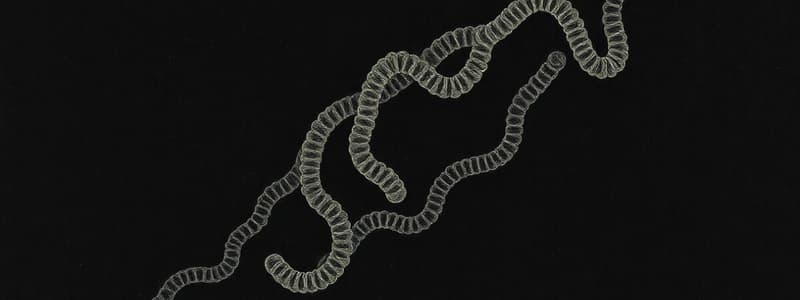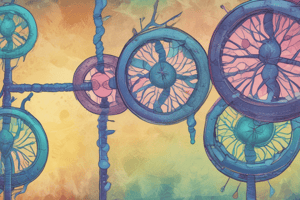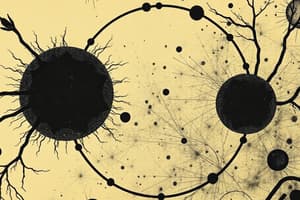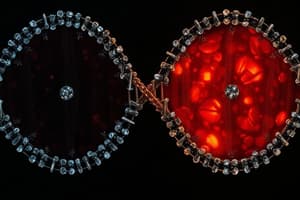Podcast
Questions and Answers
What is the primary function of the mitotic spindle during cell division?
What is the primary function of the mitotic spindle during cell division?
- To dissolve the nuclear envelope
- To elongate the cleavage furrow
- To form microfilaments
- To separate chromosomes (correct)
Which protein is compared to tubulin in prokaryotic cell division processes?
Which protein is compared to tubulin in prokaryotic cell division processes?
- Actin
- FtsZ (correct)
- Myosin
- Crysin
What structural component makes up the mitotic spindle fibers?
What structural component makes up the mitotic spindle fibers?
- Microfilaments
- Polymers of RNA
- Microtubules (correct)
- Plasma membranes
During cell division in eukaryotes, what happens to the nuclear envelope?
During cell division in eukaryotes, what happens to the nuclear envelope?
Which type of cells exhibit intermediary steps in division that relate to the mitotic spindle?
Which type of cells exhibit intermediary steps in division that relate to the mitotic spindle?
What are the three stages of interphase?
What are the three stages of interphase?
During which phase does DNA replication occur?
During which phase does DNA replication occur?
What happens to the centrosome during the S phase?
What happens to the centrosome during the S phase?
Which structure plays a critical role in organizing cell division?
Which structure plays a critical role in organizing cell division?
What is primarily replenished during the G2 phase?
What is primarily replenished during the G2 phase?
What do sister chromatids form during the S phase?
What do sister chromatids form during the S phase?
What phase must be completed before entering mitosis?
What phase must be completed before entering mitosis?
What is the primary role of the mitotic spindle?
What is the primary role of the mitotic spindle?
What is the purpose of the G1 checkpoint in the cell cycle?
What is the purpose of the G1 checkpoint in the cell cycle?
What are the two major phases of the cell cycle?
What are the two major phases of the cell cycle?
Which phase do cells enter when they are not actively preparing to divide?
Which phase do cells enter when they are not actively preparing to divide?
How long is the average cell cycle duration for rapidly dividing human cells?
How long is the average cell cycle duration for rapidly dividing human cells?
Which stage of interphase involves DNA replication?
Which stage of interphase involves DNA replication?
What can cause mutations to be passed to new cells during division?
What can cause mutations to be passed to new cells during division?
During which phase of the cell cycle does cytokinesis occur?
During which phase of the cell cycle does cytokinesis occur?
What happens at the cell cycle checkpoints?
What happens at the cell cycle checkpoints?
What characterizes the quiescent G0 phase?
What characterizes the quiescent G0 phase?
What occurs at the internal control checkpoints during the cell cycle?
What occurs at the internal control checkpoints during the cell cycle?
Which specialized cells can spend an entire human lifetime in G0?
Which specialized cells can spend an entire human lifetime in G0?
What is the purpose of the contractile ring composed of actin filaments during cell division?
What is the purpose of the contractile ring composed of actin filaments during cell division?
Which checkpoint assesses the attachment of kinetochores to spindle fibers?
Which checkpoint assesses the attachment of kinetochores to spindle fibers?
What happens during the mitotic phase?
What happens during the mitotic phase?
What is a common duration for epithelial cells' cell turnover in humans?
What is a common duration for epithelial cells' cell turnover in humans?
How do homologous chromosomes differ from sex chromosomes?
How do homologous chromosomes differ from sex chromosomes?
What is the cleavage furrow and how is it formed in animal cells?
What is the cleavage furrow and how is it formed in animal cells?
How do plant cells differ from animal cells during division?
How do plant cells differ from animal cells during division?
What process follows mitosis in the cell cycle?
What process follows mitosis in the cell cycle?
What structure forms between daughter cells in plant cells during cytokinesis?
What structure forms between daughter cells in plant cells during cytokinesis?
What role do Golgi vesicles play during telophase in cells?
What role do Golgi vesicles play during telophase in cells?
What happens to cells that remain in the G0 phase?
What happens to cells that remain in the G0 phase?
Which type of cells typically remains permanently in the G0 phase?
Which type of cells typically remains permanently in the G0 phase?
What is the function of enzymes that accumulate in the Golgi apparatus during interphase?
What is the function of enzymes that accumulate in the Golgi apparatus during interphase?
What is a consequence of minor mistakes in protein formation within a cell?
What is a consequence of minor mistakes in protein formation within a cell?
What are proto-oncogenes responsible for in the cell cycle?
What are proto-oncogenes responsible for in the cell cycle?
What happens when a proto-oncogene is mutated into an oncogene?
What happens when a proto-oncogene is mutated into an oncogene?
What occurs following a mutation that enhances the activity of Cdk?
What occurs following a mutation that enhances the activity of Cdk?
What could happen to daughter cells that originate from a mutated parent cell?
What could happen to daughter cells that originate from a mutated parent cell?
What role do tumor suppressor genes play in the context of cell cycle regulation?
What role do tumor suppressor genes play in the context of cell cycle regulation?
How can an increase in mutations in cell cycle regulatory genes impact the cells?
How can an increase in mutations in cell cycle regulatory genes impact the cells?
What is the effect of a cell inheriting a mutation in a positive regulator gene?
What is the effect of a cell inheriting a mutation in a positive regulator gene?
Flashcards
Homologous Chromosomes
Homologous Chromosomes
Pairs of chromosomes with similar gene sequences.
Sex Chromosomes
Sex Chromosomes
X and Y chromosomes that differ significantly in gene content.
Interphase
Interphase
The cell growth and DNA replication stage before mitosis.
Mitosis
Mitosis
Signup and view all the flashcards
Cytokinesis
Cytokinesis
Signup and view all the flashcards
Cell Cycle
Cell Cycle
Signup and view all the flashcards
G1 Phase
G1 Phase
Signup and view all the flashcards
G2 Phase
G2 Phase
Signup and view all the flashcards
Cleavage furrow formation
Cleavage furrow formation
Signup and view all the flashcards
Cell plate formation
Cell plate formation
Signup and view all the flashcards
Cleavage furrow location
Cleavage furrow location
Signup and view all the flashcards
Cell plate formation location
Cell plate formation location
Signup and view all the flashcards
Cell wall material
Cell wall material
Signup and view all the flashcards
Golgi apparatus role
Golgi apparatus role
Signup and view all the flashcards
Interphase stages
Interphase stages
Signup and view all the flashcards
Cytokinesis difference in plants/animals
Cytokinesis difference in plants/animals
Signup and view all the flashcards
Sister Chromatids
Sister Chromatids
Signup and view all the flashcards
Mitotic phase
Mitotic phase
Signup and view all the flashcards
Centrosome
Centrosome
Signup and view all the flashcards
DNA Replication (in Interphase)
DNA Replication (in Interphase)
Signup and view all the flashcards
Cell cycle length variation
Cell cycle length variation
Signup and view all the flashcards
Internal checkpoints
Internal checkpoints
Signup and view all the flashcards
G1 checkpoint
G1 checkpoint
Signup and view all the flashcards
Mitotic Spindle
Mitotic Spindle
Signup and view all the flashcards
G2 checkpoint
G2 checkpoint
Signup and view all the flashcards
Cleavage Furrow
Cleavage Furrow
Signup and view all the flashcards
M checkpoint
M checkpoint
Signup and view all the flashcards
FtsZ Protein
FtsZ Protein
Signup and view all the flashcards
Daughter cells
Daughter cells
Signup and view all the flashcards
Microtubules
Microtubules
Signup and view all the flashcards
Binary Fission
Binary Fission
Signup and view all the flashcards
Proto-oncogenes
Proto-oncogenes
Signup and view all the flashcards
Oncogenes
Oncogenes
Signup and view all the flashcards
Tumor Suppressor Genes
Tumor Suppressor Genes
Signup and view all the flashcards
What happens when a proto-oncogene mutates?
What happens when a proto-oncogene mutates?
Signup and view all the flashcards
What happens when a tumor suppressor gene mutates?
What happens when a tumor suppressor gene mutates?
Signup and view all the flashcards
How do mutations accumulate?
How do mutations accumulate?
Signup and view all the flashcards
Why is the pace of the cell cycle affected?
Why is the pace of the cell cycle affected?
Signup and view all the flashcards
What happens to cells with uncorrected DNA damage?
What happens to cells with uncorrected DNA damage?
Signup and view all the flashcards
Study Notes
Reproduction at the Cellular Level
- Cells reproduce through cell division
- Cell reproduction is important for growth, repair, and regeneration of tissues in multicellular organisms
- Single-celled organisms use cell division for reproduction
- The genome is a cell's complete set of DNA
- Prokaryotic genome is a single, double-stranded DNA molecule in a loop or circle, located in the nucleoid region
- Eukaryotic genome consists of several linear DNA molecules bound with proteins to form chromosomes
- Humans have 46 chromosomes (2n) in somatic cells, and 23 chromosomes (n) in sex cells (gametes)
- Homologous chromosomes are matched pairs of chromosomes with the same length and gene locations
- Genes are functional units of chromosomes that code for proteins, determining traits (different forms of characteristics)
- Chromosomes are responsible for traits, and different combinations lead to individual variation
The Cell Cycle
- The cell cycle is an ordered sequence of stages from a single parent cell dividing to produce two new daughter cells
- Interphase is the growth and DNA replication phase (G1, S, and G2 phases)
- G1 phase: cell growth, protein synthesis, accumulating materials for DNA replication
- S phase: DNA synthesis copying the genetic material and doubling the amount of DNA, and replication of centrosomes
- G2 phase: further cell growth, protein synthesis, preparing for cell division, and accumulating energy reserves
- Mitotic phase: the division of the duplicated DNA and cytoplasmic contents (mitosis and cytokinesis)
Cancer and the Cell Cycle
- Cancer is uncontrolled cell division
- Proto-oncogenes are normal genes with positive cell-cycle regulators; if mutated, they become oncogenes
- Tumor suppressor genes are negative cell-cycle regulators; if mutated, they can lead to uncontrolled cell growth.
- Mutations in genes that regulate the cell cycle can cause cancer
- Mutated p53 genes have been found in many cancers, and prevent cells that are damaged from dying
- Checkpoints control the cell cycle, making sure everything is correct before going to the next phase
Prokaryotic Cell Division
- Binary fission is the process of prokaryotic cell division
- During binary fission, the single circular chromosome is replicated, and two copies then move to opposite ends of the cell
- The cell elongates, and a septum is formed in the middle of the cell, separating the replicated DNA into two new cells
- FtsZ protein plays a critical role in cytokinesis in dividing prokaryotic cells, similar to tubulin in eukaryotic cells.
Studying That Suits You
Use AI to generate personalized quizzes and flashcards to suit your learning preferences.




